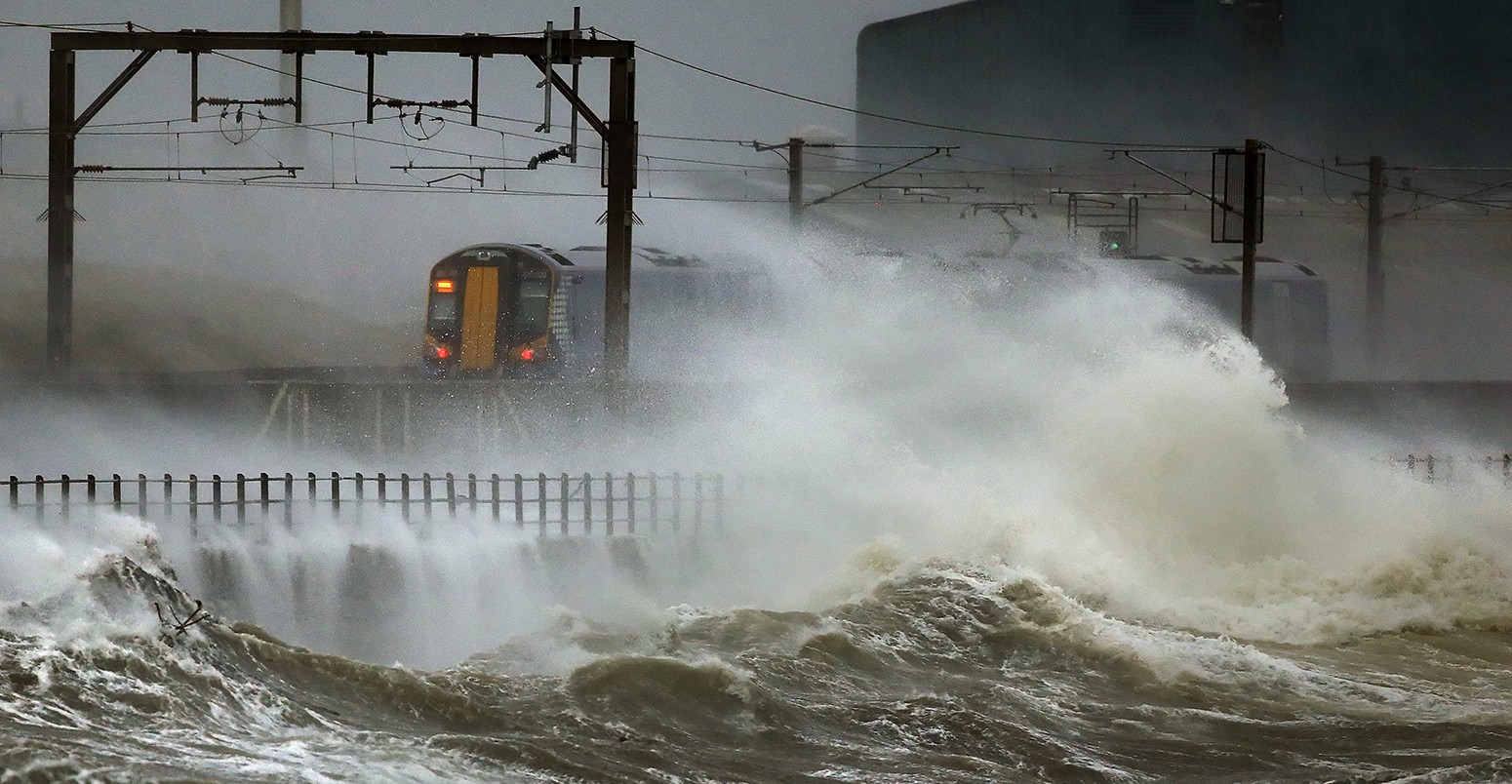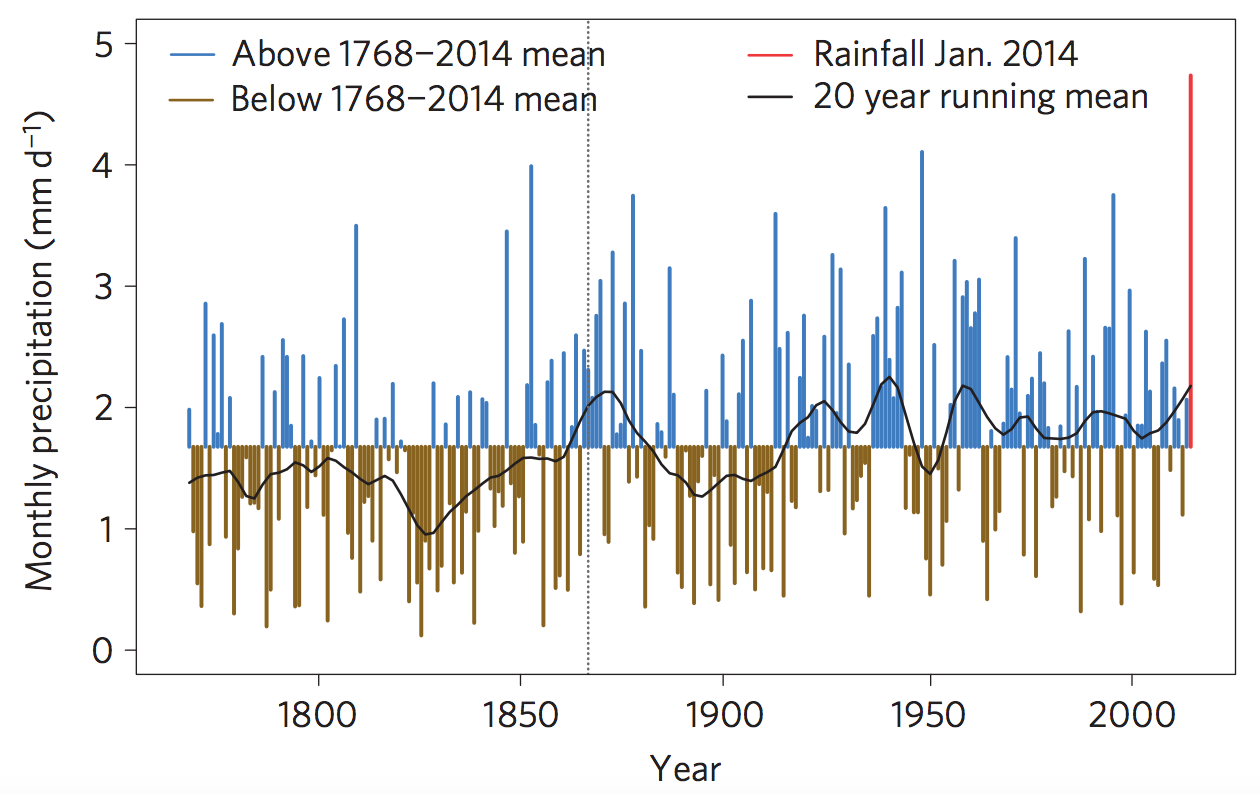
Climate change boosted odds of UK 2013-14 wet winter by 43%
Robert McSweeney
02.01.16Robert McSweeney
01.02.2016 | 4:00pmWhile much of the UK is still getting over the recent bout of flooding, a new study takes us back two years to the winter floods of 2013-14.
The findings suggest that climate change made the sustained wet and stormy weather 43% more likely – and put an extra 1,000 houses at risk of flooding along the River Thames.
The results confirm preliminary figures presented at an international conference in April 2014, one of the study’s authors tells Carbon Brief.
Succession of storms
The 2013-14 winter saw a “near-continuous succession of low-pressure systems moving in from the Atlantic and across southern England,” says the new Nature Climate Change paper.
The wet and windy weather brought floods and storm surges to much of Southern England and Wales, resulting in 18,700 insurance claims and £451m of insured losses.
This flooding wasn’t caused by a few extremely wet days, the paper says, but by sustained heavy rainfall across the whole season. At the Radcliffe Observatory in Oxford, for example, both January 2014 and the winter as a whole set new rainfall records in a dataset that goes back to 1767. Yet no individual 5-day period of rainfall was record-breaking.

Monthly rainfall totals 1768–2014 at the Radcliffe Observatory, Oxford. Bars show months of rain above average (blue) and below average (brown). Red bar indicates January 2014 total and the black line is the 20-year running monthly average. Dotted black line shows the point at which measurements included snow as well as rain. Source: Schaller et al. (2016).
The new attribution study doesn’t just consider the influence of human-caused climate change on the extreme winter weather, but also on the high river flows and the eventual flood damage it caused. This approach makes the study the first of its kind, says Prof Ted Shepherd from the University of Reading, who wasn’t involved in the project. He says:
“This is a very interesting study, as it is the first to perform an end-to-end estimate of climate change impacts for an extreme weather event…Furthermore, it is novel in attempting to distinguish between different sources of uncertainty in the attribution.”
Model simulations
The study made use of the weather@home project, which is part of the University of Oxford’s climateprediction.net modelling experiment. This borrows spare processing capacity on the home computers of thousands of volunteers to allow scientists to run climate model simulations.
In total, the researchers ran almost 135,000 simulations of the Europe’s weather during the winter of 2013/14. The idea is to use slightly different – but equally possible – starting conditions in each model run, to work out the overall chances of such wet weather occurring. They ran the models for the climate we have today and the climate we’d have if human hadn’t added greenhouse gases to the atmosphere.
The results show that, in a world without climate change, southern England could expect a winter as wet as 2013-14 about once every 100 years.
But the simulations with climate change show that greenhouse gas emissions had made the record-breaking wet January 43% more likely. This pushed the likelihood of the 2013-14 wet winter to once every 70 years.
Using a computer model of the Thames river, the researchers then worked out what effect such a wet winter could have had on water levels in the river, and hence the number houses at risk from flooding.
Their findings show that climate change could have boosted monthly peak and daily peak river flows at Kingston upon Thames by 21% and 4%, respectively. These higher river flows would put an extra 1,000 houses at risk from flooding, the researchers say.
As the average insurance claim for a flooded house during the 2013-14 winter was £24,000, the paper says climate change could have added £24million to the UK’s overall insurance bill.
Here’s Dr Natalie Schaller from Oxford University, lead author on the new paper, to explain more about the weather@home project, how attribution studies work and how the team arrived at the new results.
Nathalie Schaller, the lead author of the paper in Nature Climate Change, explains the motivation and design of the experiment in January 2014 — in front of a badly flooded River Cherwell in Oxford. Credit: Fabio Crameri and Deborah Strickland.More moisture, more storms
The researchers also managed to pin down what aspects of climate had changed to make such a wet winter more likely.
They attribute about two-thirds of the increase in likelihood to the atmosphere being able to hold more moisture because the world is warming up. This brings a higher risk of heavy rainfall events.
They attribute the remaining third to the position of the jet stream – a thin, fast flowing ribbon of air high up in the atmosphere that acts to steer weather systems towards the UK.
The jet stream was unusually strong during the 2013-14 winter, creating ideal conditions for the sequence of strong storms to cross the Atlantic and hit the UK.
How climate change affects the jet stream is an ongoing area of research, says co-author Dr Neil Massey, a researcher at the University of Oxford, but their study shows that the flow of storms during the 2013-14 winter was more likely in a warmer climate. He tells Carbon Brief:
Our paper shows that it is more likely that this westerly flow regime is occupied under a changed climate than under a non-anthropogenic climate.
Improved accuracy
At the European Geosciences Union (EGU) conference back in April 2014, some of the same researchers presented preliminary findings that climate change had made the 2013-14 wet winter 25% more likely.
So how do the new, now peer-reviewed, findings differ?
The updated figure of 43% is within the range of uncertainty of their preliminary figures presented at EGU, says Massey. The main difference is that they have been able to run more model simulations, known as “ensemble members”. This means they can be more certain about the results, he says:
Having more ensemble members enables us to pin down the result much more accurately, but it is edifying to know that we had the correct magnitude of change and that the sign was correct – i.e. a positive attribution in both results.
The research highlights what the fast-moving field of attribution can tell us about the influence of climate change on our extreme weather. And we can expect more of these studies to follow in the wake of another very wet winter.
Main image: A train passes along the coast at Saltcoats in Scotland which is battered by big sea waves on 3 January 2014 as Britain is braced for the worst as a combination of high tides, heavy rains and strong winds are expected to bring yet more severe flooding to parts of the country.
Schaller, N. et al. (2016) Human influence on climate in the 2014 Southern England winter floods and their impacts, Nature Climate Change, doi:10.1038/nclimate2927.

